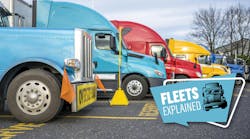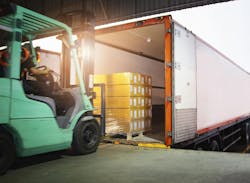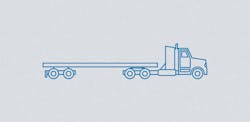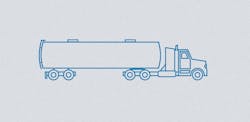The trucking industry’s importance to the U.S. economy can’t be understated. Over-the-road fleets haul 72.6%—nearly 12 billion tons—of all U.S. freight. This $940.8 billion industry accounts for more than 80% of the nation's freight bill. But to an outsider—or a new industry member—how trucking is segmented can be overwhelming. Here’s a breakdown of the basic trucking segments and how the industry is categorized.
What is the difference between trucking segments?
Understanding the different segments of the trucking industry isn’t an easy feat. That’s because there are multiple ways to categorize the industry; any one fleet can and will fit into multiple segments. Overall, there are five main ways to categorize the industry:
- Carrier type
- Cargo type
- Commodity
- Operating distance
- Truck type
What are trucking carrier types?
Load size refers to the amount of cargo a truck hauls from one or a variety of shippers. The types of load sizes can be broken down into four categories: full truckload, less-than-truckload, private, and courier, which can also be lumped in with final-mile delivery.
Full truckload: According to the National Motor Freight Traffic Association, FTL can simply be defined as a shipment that takes up the space of a full truck trailer. With FTL, cargo is loaded onto a truck and taken from Point A to Point B, usually with no other cargo stops. This method of shipping is typically popular for businesses needing to move a large amount of cargo. Each year, FleetOwner ranks the largest for-hire U.S. fleets in the FleetOwner 500: For-Hire.
Less-than-truckload: LTL shipments are like they sound—one batch of cargo from one source isn’t large enough to take up a whole trailer, so the trailer is instead filled with cargo from multiple sources. According to the NMFTA, the truck will make multiple stops to pick up and deliver cargo, or the cargo is separated at a distribution center and loaded onto smaller vehicles for delivery. LTL works best for shipments that are small and less time-sensitive.
Private: According to the National Private Truck Council, a private fleet can be defined as an in-house truck fleet operation, often incorporated as a separate company, in service to a parent corporation whose primary business, such as manufacturing or retailing, is not trucking. One example of a private fleet is Walmart, whose primary business is retail but also has its own fleet. Each year, FleetOwner ranks the largest corporations in the U.S. based on their private trucking fleet operations in the FleetOwner 500: Private.
Courier: Includes well-known carrier brands such as FedEx, UPS, DHL, and the U.S. Postal Service. It also can include private fleets such as Amazon and grocers who deliver their own goods directly to consumers. More recently, courier delivery is sometimes included within last-mile classifications that bring a delivery to its final destination, such as a front porch or mailbox. Most courier and e-commerce-related final-mile deliveries are completed with medium- and light-duty vans and trucks, as opposed to LTL and truckload operations that use tractor-trailers or heavy-duty straight trucks. Because parcel delivery drivers are operating smaller equipment, they usually do not need a commercial driver’s license, which opens up the hiring pool for these fleets.
See also: Fleets Explained: How the trucking industry works
What are trucking’s cargo types?
Trucking segments can also be broken down by cargo type, as different cargo types require different kinds of trucks and shipment processes. The main four types of cargo are general, bulk dry, bulk liquid, and refrigerated.
- General: General cargo refers to goods that need to be transported in boxes, bags, barrels, etc., according to Inbound Logistics. On the other hand, the two kinds of bulk cargo defined next are shipped in special bulk trucks without any additional packaging.
- Bulk dry: According to Inbound Logistics, dry bulk cargo is goods shipped in raw, unprocessed forms, like grains, minerals, and ore.
- Bulk liquid: Liquid bulk cargo is goods shipped as liquids, such as oils or chemicals, according to Inbound Logistics.
- Refrigerated: Some cargo requires a temperature-controlled trailer, such as perishable food.
What kind of commodities rely on trucking?
While cargo types are more general, breaking the trucking industry down by commodity becomes more specific. Trucking commodities refer to the particular types of cargo trucks can carry, including subsections of general and bulk freight. There are many different types of commodities and sub-commodities, but this section will cover the main six according to Altexsoft.
- Agricultural: Harvested foods and goods and livestock
- Building materials/construction: Lumber, cement, steel, etc.
- Heavy haul: Machinery, equipment, mobile homes, etc.
- Household goods: Clothing, electronics, etc.
- Motor vehicle: Cars, vans, trucks, etc.
- Bulk: Petroleum, food-grade liquids, hazardous materials, etc.
- Refrigerated: Foodservice, pharmaceuticals, etc.
How do operating distances vary in trucking?
Operating distances refer to the area in which a trucking company operates. Every trucking company operates in a different area span, with some areas longer than others. The types of operating distances can be broken down into three categories: local, regional, and long haul.
Local: According to Schneider National, local truck drivers operate close to home and deliver cargo in a single day, returning to their own homes at night. Local truck drivers operate in their own state if not their own city, usually making multiple stops along their routes.
Regional: Regional trucking, also known as short-haul, branches out from a local truck’s operating distance to include a few states in a general area, according to Indeed. Truck drivers carry cargo in states typically within a 250-mile radius. Most regional truck drivers return to their home base at the end of their shifts.
Long haul: According to Truckstop, long-haul trucking or over-the-road trucking can be defined as covering distances of 250 to 1,000 miles or more. This means drivers take longer trips than in local or regional hauling, sometimes spending weeks away from home.
What are the different kinds of trucking and freight trailers?
Truck types refer to a truck’s make, its trailer’s make, and the truck’s purpose. Some trucks and trailers are designed to haul specific kinds of cargo; once you know your truck types, it’s easier to spot one on the road and know what kind of cargo that truck might be carrying. There are many truck types, but the four main ones to know are dry van, reefer, flatbed, and tanker.
Dry van
According to Trucker Path, dry vans are the most common type of truck. Dry vans are the standard truck you’ll see most often on the road, with a 53-foot trailer. Dry vans typically haul general freight and especially household items.
Reefer
A refrigerated truck, more commonly known in the industry as a reefer, is special because its trailer is temperature-controlled. This makes reefers perfect for hauling goods that must stay at a certain temperature, like perishable food, pharmaceuticals, and chemicals, according to Trucker Path.
Flatbed
Flatbed trucks are visually different than dry vans and reefers, characterized by a flat, open trailer. According to Trucker Path, this design makes flatbed trucks more suited for large freight that may not fit in a a dry van. Typically, flatbed trucks haul construction goods, manufactured goods, and other oversized loads; all freight has to be secured with straps, tarps, and other locking devices.
Tanker
According to Trucker Path, tanker trucks are categorized by a cylinder-shaped trailer. This kind of trailer is used to transport dry bulk cargo or liquid bulk cargo.










